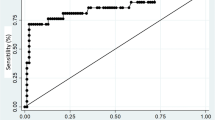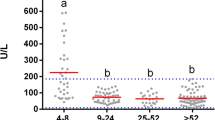Abstract
The objective of this study was to establish a reference interval for serum zinc in dogs and to determine the factors that affected it. We collected samples from 197 clinically healthy animals of various breeds and ages and obtained information about their sex, neuter status, age, breed, diet, lifestyle, weight, and body condition score. Serum zinc concentration was measured by a colorimetric method using a clinical chemistry analyzer. We established the reference interval for serum zinc as 4.9–19.7 µmol/L. When assessing the relationship of zinc with various biochemical parameters, we found significant correlation with albumin and triacylglycerols. The only observed factor that significantly influenced serum concentration was sex. Female dogs had higher levels (median 11.0 µmol/L) than males (median 8.9 µmol/L). The difference between intact females and intact males was also significant (medians 11.6 and 9.0 µmol/L respectively), but it was only numerical for neutered animals (median of neutered females 10.7 µmol/L and of neutered males 8.7 µmol/L). Despite the general belief that homemade food for dogs contains a lower amount of zinc than a commercial one, diet did not influence zinc serum levels significantly. There was also no impact of age, breed, lifestyle, weight, or body condition score on serum zinc concentration.



Similar content being viewed by others
References
Raulin J (1869) Etudes chimique sur la vegetation (Chemical studies on plants). Ann Sci Nat 11:93–99
Todd WR, Elvehjem CA, Hart EB (1980) Zinc in the nutrition of the rat. Nutr Rev 38:151–154. https://doi.org/10.1111/j.1753-4887.1980.tb05879.x
Prasad AS, Halsted JA, Nadimi M (1961) Syndrome of iron deficiency anemia, hepatosplenomegaly, hypogonadism, dwarfism and geophagia. Am J Med 31:532–546. https://doi.org/10.1016/0002-9343(61)90137-1
Robertson BT, Burns MJ (1963) Zinc metabolism and the zinc-deficiency syndrome in the dog. Am J Vet Res 24:997–1002
National Research Council (2006) Nutrient requirements of dogs and cats. Washington DC, Washington, pp. 173–177
Pereira AM, Maia MRG, Fonseca AJM, Cabrita ARJ (2021) Zinc in dog nutrition, health and disease: a review. Animals (Basel) 11:978. https://doi.org/10.3390/ani11040978
European Pet Food Industry Federation (2021) Nutritional guidelines for complete and complementary pet food for cats and dogs. https://europeanpetfood.org/wp-content/uploads/2022/03/Updated-Nutritional-Guidelines.pdf. Accessed 25 July 2022
Dorsten CM, Cooper DM (2004) Use of body condition scoring to manage body weight in dogs. Contemp Top Lab Anim Sci 43:34–37. https://www.ingentaconnect.com/contentone/aalas/jaalas/2004/00000043/00000003/art00007?crawler=true. Accessed 26 July 2022
Geffré A, Concordet D, Braun JP, Trumel C (2011) Reference Value Advisor: a new freeware set of macroinstructions to calculate reference intervals with Microsoft Excel. Vet Clin Pathol 40:107–112. https://doi.org/10.1111/j.1939-165x.2011.00287.x
Poulsen OM, Holst E, Christensen JM (1997) Calculation and application of coverage intervals for biological reference values (Technical report). Pure Appl Chem 69:1601–1611. https://doi.org/10.1351/pac199769071601/html
Cedeño Y, Miranda M, Orjales I, Herrero-Latorre C, Suárez M, Luna D, López-Alonso M (2020) Serum concentrations of essential trace and toxic elements in healthy and disease-affected dogs. Animals (Basel) 10:1052. https://doi.org/10.3390/ani10061052
van den Broek AH, Stafford WL (1988) Diagnostic value of zinc concentrations in serum, leucocytes and hair of dogs with zinc-responsive dermatosis. Res Vet Sci 44:41–44. https://reader.elsevier.com/reader/sd/pii/0034528888900112?token=D781DC0A8A69A093C5C2275488114341C8596AEDCAD740ED65D96B00E7C4967DD6AB836DC5973A44282539004E4DC173&originRegion=eu-west-1&originCreation=20220726133332. Accessed 26 July 2022
Mert H, Mert N, Dogan I, Cellat M, Yasar S (2008) Element status in different breeds of dogs. Biol Trace Elem Res 125:154–159. https://doi.org/10.1007/s12011-008-8160-5
Vitale S, Hague DW, Foss K, de Godoy MC, Selmic LE (2019) Comparison of serum trace nutrient concentrations in epileptics compared to healthy dogs. Front Vet Sci 6:467. https://doi.org/10.3389/fvets.2019.00467
Kazmierski KJ, Ogilvie GK, Fettman MJ, Lana SE, Walton JA, Hansen RA, Richardson KL, Hamar DW, Bedwell CL, Andrews G, Chavey S (2001) Serum zinc, chromium, and iron concentrations in dogs with lymphoma and osteosarcoma. J Vet Intern Med 15:585–588. https://doi.org/10.1892/0891-6640(2001)0152.3.co;2
Tomza-Marciniak A, Pilarczyk B, Bąkowska M, Ligocki M, Gaik M (2012) Lead, cadmium and other metals in serum of pet dogs from an urban area of NW Poland. Biol Trace Elem Res 149:345–351. https://doi.org/10.1007/s12011-012-9433-6
Vannucchi CI, Jordao AA, Vannucchi H (2007) Antioxidant compounds and oxidative stress in female dogs during pregnancy. Res Vet Sci 83:188–193. https://doi.org/10.1016/j.rvsc.2006.12.009
Grützner N, Heilmann RM, Cranford SM, Holzenburg A, Suchodolski JS, Steiner JM (2015) Inflammatory, immunological, and intestinal disease biomarkers in Chinese Shar-Pei dogs with marked hypocobalaminemia. J Vet Diagn Invest 27:31–40. https://doi.org/10.1177/1040638714560881
Hall AG, King JC, McDonald CM (2021) Comparison of serum, plasma, and liver zinc measurements by AAS, ICP-OES, and ICP-MS in diverse laboratory settings. Biol Trace Elem Res 200:2606–2613. https://doi.org/10.1007/s12011-021-02883-z
Mishra J, Carpenter S, Singh S (2010) Low serum zinc levels in an endemic area of visceral leishmaniasis in Bihar, India. Indian J Med Res 131:793–798. https://www.researchgate.net/profile/Sarman-Singh/publication/44695541_Low_serum_zinc_levels_in_an_endemic_area_of_visceral_leishmaniasis_in_Bihar_India/links/0deec52788946149b8000000/Low-serum-zinc-levels-in-an-endemic-area-of-visceral-leishmaniasis-in-Bihar-India.pdf. Accessed 26 July 2022
Matar A, Jennani S, Abdallah H, Mohsen N, Borjac J (2020) Serum iron and zinc levels in Lebanese multiple sclerosis patients. Acta Neurol Taiwan 29:5–11. https://www.bau.edu.lb/BAUUpload/RPTFullDocuments/Science/Serum%20Iron_04052021212615-Science.pdf. Accessed 26 July 2022
Afroz L, Nessa A, Parveen S, Tanvir IA, Sharmin A, Yeasmin F, Meherubin F, Mumu NS, Azad AB (2021) Relation of serum iron level with serum zinc level among adolescent girls with iron deficiency anaemia in Bangladesh. Mymensingh Med J 30:609–612
Makino T, Saito M, Horiguchi D, Kina K (1982) A highly sensitive colorimetric determination of serum zinc using water-soluble pyridylazo dye. Clin Chim Acta 120:127–135. https://www.sciencedirect.com/science/article/pii/0009898182900833. Accessed 26 July 2022
Escobedo Monge M, Barrado E, Alonso Vicente C, Marugán de Miguelsanz JM (2018) Comparison study between colorimetric method and flame atomic absorption spectrophotometry in serum zinc status. Nutr clín diet hosp 38:128–133. https://uvadoc.uva.es/bitstream/handle/10324/38722/ESCOBEDO1.pdf?sequence=1. Accessed 26 July 2022
Lee YR, Kang MH, Park HM (2016) Treatment of zinc toxicosis in a dog with chelation using d-penicillamine. J Vet Emerg Crit Care (San Antonio) 26:825–830. https://doi.org/10.1111/vec.12414
Bischoff K, Chiapella A, Weisman J, Crofton LM, Hillebrandt J (2017) Zinc toxicosis in a Boxer dog secondary to ingestion of holiday garland. J Med Toxicol 13:263–266. https://doi.org/10.1007/s13181-017-0602-z
Siow JW (2018) Zinc toxicosis in a dog secondary to prolonged zinc oxide ingestion. Open Vet J 8:458–462. https://doi.org/10.4314/ovj.v8i4.17
Cedeño Y, Miranda M, Orjales I, Herrero-Latorre C, Suárez M, López-Alonso LDM (2020) Trace element levels in serum are potentially valuable diagnostic markers in dogs. Animals (Basel) 10:2316. https://doi.org/10.3390/ani10122316
Masuoka J, Saltman P (1994) Zinc(II) and copper(II) binding to serum albumin. A comparative study of dog, bovine, and human albumin. J Biol Chem 269:25557–25561. https://www.jbc.org/article/S0021-9258(18)47285-7/pdf. Accessed 26 of July 2022
Passlack N, Mainzer B, Lahrssen-Wiederholt M, Schafft H, Palavinskas R, Breithaupt A, Zentek J (2015) Concentrations of strontium, barium, cadmium, copper, zinc, manganese, chromium, antimony, selenium, and lead in the liver and kidneys of dogs according to age, gender, and the occurrence of chronic kidney disease. J Vet Sci 16:57–66. https://doi.org/10.4142/jvs.2015.16.1.57
Davies M, Alborough R, Jones L, Davis C, Williams C, Gardner DS (2017) Mineral analysis of complete dog and cat foods in the UK and compliance with European guidelines. Sci Rep 7:17107. https://doi.org/10.1038/s41598-017-17159-7
Gagné JW, Wakshlag JJ, Center SA, Rutzke MA, Glahn RP (2013) Evaluation of calcium, phosphorus, and selected trace mineral status in commercially available dry foods formulated for dogs. J Am Vet Med Assoc 243:658–666. https://doi.org/10.2460/javma.243.5.658
Zafalon RVA, Risolia LW, Vendramini THA, Ayres Rodrigues RB, Pedrinelli V, Teixeira FA, Rentas MF, Perini MP, Alvarenga IS, Brunetto MA (2020) Nutritional inadequacies in commercial vegan foods for dogs and cats. PLoS One 15:e0227046. https://doi.org/10.1371/journal.pone.0227046
Regulation (EC) No 1831/2003 of the European Parliament and of the Council of 22 September 2003 on additives for use in animal nutrition. Official Journal. https://eur-lex.europa.eu/legal-content/EN/TXT/PDF/?uri=CELEX:32003R1831&rid=10. Accessed 26 July 2022
Gregório BJR, Pereira AM, Fernandes SR, Matos E, Castanheira F, Almeida AA, Foneseca AJM, Cabrita ARJ, Segundo MA (2020) Flow-based dynamic approach to assess bioaccessible zinc in dry dog food samples. Molecules 25:1333. https://doi.org/10.3390/molecules25061333
Pedrinelli V, Zafalon RVA, Rodrigues RBA, Perini MP, Conti RMC, Vendramini THA, de Carvalho Balieiro JC, Brunetto MA (2019) Concentrations of macronutrients, minerals and heavy metals in home-prepared diets for adult dogs and cats. Sci Rep 9:13058. https://doi.org/10.1038/s41598-019-49087-z
Larsen JA, Parks EM, Heinze CR, Fascetti AJ (2012) Evaluation of recipes for home-prepared diets for dogs and cats with chronic kidney disease. J Am Vet Med Assoc 240:532–538. https://doi.org/10.2460/javma.240.5.532
Lowe JA, Wiseman J, Cole DJ (1994) Zinc source influences zinc retention in hair and hair growth in the dog. J Nutr 124:2575S-2576S. https://doi.org/10.1093/jn/124.suppl_12.2575S
Kuhlman G, Rompala RE (1998) The influence of dietary sources of zinc, copper and manganese on canine reproductive performance and hair mineral content. J Nutr 128:2603S-2605S. https://doi.org/10.1093/jn/128.12.2603S
Pereira AM, Guedes M, Matos E, Pinto E, Almeida AA, Segundo MA, Correia A, Vilanova M, Fonseca AJM, Cabrita ARJ (2020) Effect of zinc source and exogenous enzymes supplementation on zinc status in dogs fed high phytate diets. Animals (Basel) 10:400. https://doi.org/10.3390/ani10030400
Ozpinar H, Abas I, Bilal T, Demirel G (2001) Investigation of excretion and absorption of different zinc salts in puppies. Lab Anim 35:282–287. https://doi.org/10.1258/0023677011911615
Rios-Lugo MJ, Madrigal-Arellano C, Gaytán-Hernández D, Hernández-Mendoza H, Romero-Guzmán ET (2020) Association of serum zinc levels in overweight and obesity. Biol Trace Elem Res 198:51–57. https://doi.org/10.1007/s12011-020-02060-8
Ghayour-Mobarhan M, Taylor A, New SA, Lamb DJ, Ferns GA (2005) Determinants of serum copper, zinc and selenium in healthy subjects. Ann Clin Biochem 42:364–375. https://doi.org/10.1258/0004563054889990
Funding
This research was funded by University of Veterinary Sciences Brno (Internal Grant Agency 201/2021/FVHE).
Author information
Authors and Affiliations
Contributions
All authors contributed to the study conception and design. Methodology was prepared by Alena Pechová and Simona Kovaříková, and data collection and analysis were performed by Viola Zentrichová. The first draft of the manuscript was written by Viola Zentrichová and all authors commented on previous versions of the manuscript. All authors read and approved the final manuscript.
Corresponding author
Ethics declarations
Ethics Approval
The clinical study was approved by the Ethics Committee of the University of Veterinary Sciences Brno (REFNO: ES_9-2022_Zentrichova). All procedures were following national legislation of the Czech Republic (Act No. 246/1992 Coll., on the Protection of Animals Against Cruelty, as amended) and with EU legislation (Directive 2010/63/EU revising Directive 86/609/EEC on the protection of animals used for scientific purposes, as amended).
Consent to Participate
Informed consent was obtained from all owners of animals involved in the study.
Competing Interests
The authors declare no competing interests.
Additional information
Publisher's Note
Springer Nature remains neutral with regard to jurisdictional claims in published maps and institutional affiliations.
Rights and permissions
Springer Nature or its licensor holds exclusive rights to this article under a publishing agreement with the author(s) or other rightsholder(s); author self-archiving of the accepted manuscript version of this article is solely governed by the terms of such publishing agreement and applicable law.
About this article
Cite this article
Zentrichová, V., Pechová, A. & Kovaříková, S. Zinc Concentration in Blood Serum of Healthy Dogs. Biol Trace Elem Res 201, 3356–3366 (2023). https://doi.org/10.1007/s12011-022-03441-x
Received:
Accepted:
Published:
Issue Date:
DOI: https://doi.org/10.1007/s12011-022-03441-x




